As autumn approaches, mice look for warm homes with food and water in which to hunker down for the winter. Don’t let one of those homes be yours! At a recent NAPO-GPC* meeting, pest expert Dr. Dion Lerman shared tips on how to prevent, eliminate and clean up after those little rodents. Here are answers to questions you might not have known you had:
Are mice a health concern?
How do the rascals get in?
Where in the house do the critters live?
How can one prevent them from coming in?
What’s the best way to get rid of mice?
What’s the best way to safely clean up after the critters?
As with most things in life, an ounce of prevention is worth a pound of cure.

Remember the Trapper Keeper days? And the 5-subject notebook? We all used them as students but why don’t we use them today? The concept is still the same, it’s just the subjects have changed.
To-Do’s: Instead of subject, separate your to do’s into broad categories (personal, business, church for example). Use a 3 or 5 subject notebook as your one place to store it all. Create a system to prioritize like highlighting or numbering. Don’t forget about those to do’s that you keep putting off. Mix these in with some of your urgent ones.
Projects vs. To Do’s: There is a difference. Projects are made up of a lot of to do’s. That’s why a project can seem so overwhelming and never gets done. Break up that project and add those to do’s to your list.
Notebook vs. Stickies: Is your desk or computer overrun by sticky notes? Use the divided notebooks to keep track of your to do’s/ideas/projects. Stickies should be used temporarily. Regularly transfer that information to the appropriate section of the notebook.
There is no one way to keep track of your to do’s. Build upon the systems that are currently working for you. But take it one task at a time and be patient. Conquer a couple each day or set a time limit. And in today’s digital era, sometimes a good old notebook will do just fine. Just be sure that you don’t lose it because you can’t back it up!
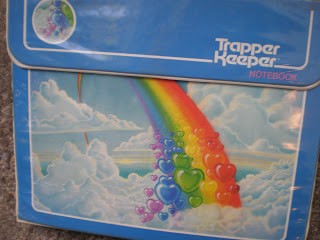
People hire organizers because they feel their lives are out of control and they are unable to get organized on their own. Frequently the problem is simply having too much stuff to organize. Often the weight of too many possessions can wear us down. When our space is cluttered and dis-organized it can impact every facet of our lives.
When the burden of too much clutter is lifted from our shoulders, we can feel physically lighter, more energetic and less stressed. This relief can lead to increased work productivity, greater enthusiasm and better relationships.
The question we need to ponder is why do we purchase so much in the first place? There are a number of explanations for this compulsion. Often, we simply want to possess the latest and greatest stuff because we think it’s fun to own! We live in a consumer culture and we often validate ourselves by what and how much we can accumulate. Consumerism and materialism are promoted by advertisers in print and on TV and computers in the form of commercials. According to Annie Leonard who wrote, “The Story of Stuff”, the two main activities Americans engage in are watching TV and shopping. We are bombarded by advertising and are exposed to approximately 3,000 ads per day. We see more ads in a day then people saw in a year 50 years ago. Couple that with the fact that the average house size has doubled since the 1970’s and it becomes easy to see why we accumulate so much “stuff”.
Sadly, in order to maintain our lifestyles of consumption, many people are working 50+ hours per week. We work until we are exhausted and depleted and then we shop to make us feel better. We return home too tired to do much else than watch TV and the cycle begins anew!
Is this the way we really want to lead our lives? If so, fine. If not, then it’s time to rethink our goals and blithely step off that hamster wheel of consumption and examine saner options.

As an organizer, I always follow my client’s lead and only suggest we work on areas THEY identify. Every once in a while, though, I notice an irritating situation that could easily be solved with a label.
This scenario came up a month ago while working in someone’s dressing area: her space has a number of zones with specific task lighting tied to a central panel.
As we were leaving the space, she went to turn off her make-up area light. Not knowing which switch controlled which light, she ended up flicking every switch, one by one, until she found the ONE she needed. Her heavy sigh told me this issue is chronic.
So we fixed her problem — right then and there.
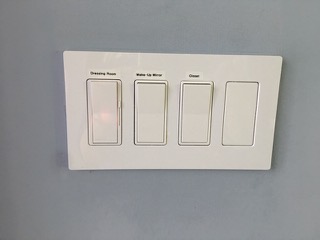
Now, if you know the story of the cobbler whose kids went barefoot, you will understand that just because I see “problem areas” in other people’s homes all day, this does not guarantee that I am a ruthless problem-solver in my own home.
Spoiler alert: not every shelf, bin or basket in my home is labeled!
Truth is, not every shelf, basket or bin NEEDS to be labeled. If it is obvious what it is and if no one is having an issue finding what they need, then there is no problem. But confusion breeds stress.
That same day, I went home and noticed myself doing the same thing to two of our three kitchen switches. That’s when I decided to do for myself what I do for others! So I labeled our switchplate. It’s been a game changer. The only thing I had to tweak was what I called them; my daughter did not think “door” made sense so we revised the label and now everyone is happy.
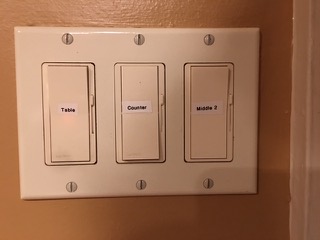
Our kitchen is the hub of our home, but now that the weather is warmer, we are spending a lot more time on our front porch.
Fast forward to the other day, when my husband texted me to make sure I turned off the front pathway lights. Our guests had stayed late the night before, and he didn’t want to waste electricity. In the daylight, I could not see if the lights were on or off… Couple that confusion with another multi-switch panel, and my stress level was rising. Without a partner to check the outdoor fixture’s bulb, it was more exercise than I expected so early in the morning. I figured it out on my own, turned the pathway lights off and did what any organized person would do: I labeled each switch.
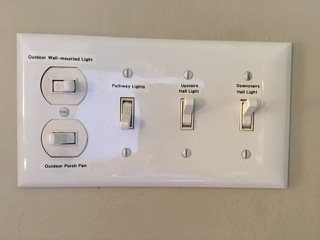
This time, my family approved of every label AND my daughter commented the next morning how helpful it was to know which switch controlled which hallway light. She had stayed up later than all — not unusual for teenagers — and knowing that we sleep with our door open at night to give our dog freedom, she didn’t want to wake us with a bright light at the top of the stairs.
My labels helped protect my investment of time, saved our daughter from waking us, and granted me an uninterrupted night’s sleep!
Think of where a label or two could help your household function a little better or brighter, or maybe even ensure a better night’s sleep for you.
Banish household confusion with a label or two; it’s illuminating!

First, let me confess: I am NOT what you might call an “Early Adopter” when it comes to technology.
I need to know that an app/program has been around a long time, is secure and is fast and easy to learn and use.
Here are 5 tech tools that meet those requirements. Use them daily to free up mental clutter, to run on time with appointments and projects, and to help you access information quickly.
You will enjoy the benefits of a calmer daily routine and the ability to access information speedily if you take a little effort to use one or more of these tech tools!
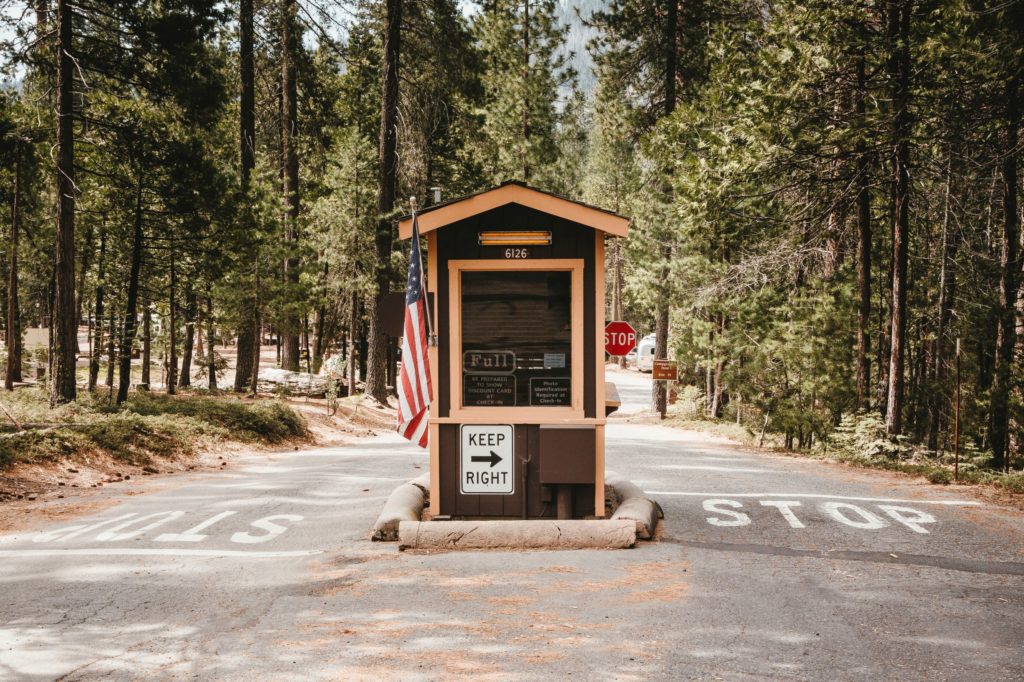
One of my favorite productivity experts, Laura Vanderkam, published her summer fun list this week, and it spurred me to create my own list. She encourages us to make time for “effortful” fun, ie things that require a little planning. That way, we don’t whittle the summertime away, wishing we had done more when Fall comes around.
I also wanted to view our summer fun list through the lens of saving money. Using Julie Morgenstern’s 4D approach, I thought about how we could “diminish” something, ie find the minimum effective dose. For example, should we pay $150 to see fireworks at Longwood Gardens or watch them for free at the local high school? Do we need to do the Phillies or would a minor league Blue Rocks game be just as fun?
So, here goes … my summer fun list!
I’ve already done the work to schedule most of these things, so now I can just sit back and let the fun happen. Happy summer everyone!